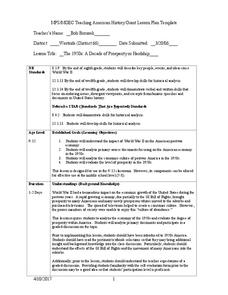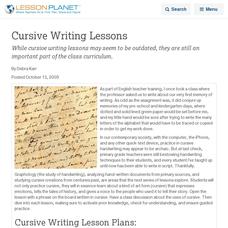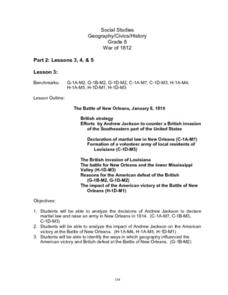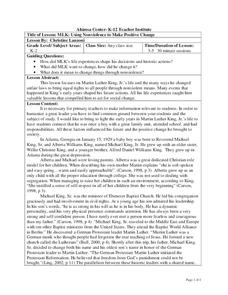Curated OER
American Economics after WWII
Young scholars analyze the American culture after WWII. Through a variety of activities, students gain an understanding of ecomonics and prosperity in the US following WWII.
Curated OER
Populism and Governor Lewelling
Seventh graders investigate the impact of the Populist Party. In this Kansas history lesson, 7th graders examine historical documents that enable them to find out what the Populist Party stood for and how Governor Lewelling dealt with...
Curated OER
Cursive Writing Lessons
While cursive writing lessons may seem to be outdated, they are still an important part of the class curriculum.
Curated OER
"The Big Bridge Scheme": The Building and Impact of the Brooklyn Bridge
Young scholars watch a video and examine archival newspaper articles to study the different points of view about the building of the Brooklyn Bridge. They examine the impact the bridge had on those living in Brooklyn and Manhattan.
Curated OER
War of 1812
Eighth graders locate the major land forms and bodies of water on a map of Louisiana. In groups, they discuss the role of the Mississippi River in the Battle of New Orleans and how land and water affect the outcome of battles. To end...
Curated OER
Power Totem
Students investigate the important symbols to Native cultures by writing a poem. In this animal totem lesson, students discuss animal spirits and their relation to the Native American lifestyle. Students write a cinquain poem about...
Curated OER
Botanical Discoveries
Sixth graders examine the Lewis and Clark Expedition. In this plant discovery lesson, 6th graders put in chronological order the plant discoveries of Lewis and Clark. Students understand the characteristics of leaves and find the area of...
Curated OER
Getting Here from There
Students role-play early 20th century immigrants on their way to Indiana. They consider the methods of travel available to them and write a letter to a friend outlining their travel plans and adventures during the trip.
Curated OER
The Renaissance: How did it change the world?
Eighth graders identify the conditions in Medieval Europe that contributed to the beginning of the Renaissance. They find characteristics of the Renaissance in its art, economy, discoveries, and ideas. They examine the ideas of Humanism...
Curated OER
Immigration: Our Changing Voices
Students identify how immigration affects the family and or community. In this Immigration lesson plan, students examine traditional migration and how immigration has changed over time. Students will consider their own families and...
Curated OER
This Land Is Our Land
Students explore land use. In this land instructional activity, students examine the use of land and land records. They create a diagram of a specified piece of land and determine the area of the land. Students discuss...
Curated OER
Case Studies of American Innovation
Studnets discover how the Industrial Revolution came to be in the United States. In this technological advancements lesson, learners research creations by Henry Ford, the Wright Brothers, and Thomas Edison. Students create PowerPoint...
Curated OER
MLK: using Nonviolence to Make Positive Change
Students read about Martin Luther King and discuss the rights and responsibilities of citizens. In this Martin Luther King instructional activity, students recognize the vocabulary words associated with freedom and...
Curated OER
Where Will I Go From Here?
Students research the various cultures in Colonial America. In this American history activity, students analyze and complie the research they find presenting what they have found into a short presentation.
Curated OER
With Malice toward None: Lincoln's Assassination
Students study the manhunt for, John Wilkes Booth, the man who assassinated Abraham Lincoln. In this instructional activity about a president, students write and role-play they are announcers who are informing...
Curated OER
The Art of Political Cartoons in Revolutionary America
High schoolers analyze political cartoons. In this colonial America lesson, students examine the provided political cartoons and respond to analytical questions about each of them.
Curated OER
Inventions Change the World: The Enigma Machine
Third graders explore WWII by analyzing technological advances. In this invention lesson, 3rd graders discuss the use of the Enigma machine which decoded private German messages that communicated with U-boats. Students utilize a timeline...
Curated OER
Parenting - Discipline and Guidance
High schoolers learn the meaning/purpose of discipline and the various parenting types leading to obedience or self-discipline.
Curated OER
Terrestrial Ecozones, Population Density and Species at Risk
Tenth graders navigate and use the online Atlas of Canada. They explain the cause and effect relationship between human settlement and the natural environment and wildlife species. They utilize a worksheet imbedded in this plan.
Curated OER
The Geography of Aboriginal Languages in Canada
Students study the relationship between geography and the Aboriginal language communities.
Curated OER
African Americans in the Maritime Trades
Students explore Civil Rights by analyzing U.S. history. In this African American workforce lesson, students discuss the history of African Americans in Baltimore and the need for steady work that formed. Students define vocabulary terms...
Curated OER
Abolition and the Underground Railroad in Essex County
Fifth graders investigate the end of slavery and the hidden paths slaves used to travel. In this U.S. history lesson, 5th graders examine the travel routes slaves used in Essex County known as the Underground Railroad....
Curated OER
What Can We Discover About Colorado?
Students locate Colorado and its neighbors on a map (either in a book or on the Internet). They create a graphic that illustrates what they know and want to know about the state (KWL); finally, they draw and label Louisiana maps.
Curated OER
Nevada Mines 1850-1880
Students explore the Nevada mining of 1850-1880. In this history lesson, students investigate the Comstock Lode and examine the mining tools that were used to search for silver and gold.


